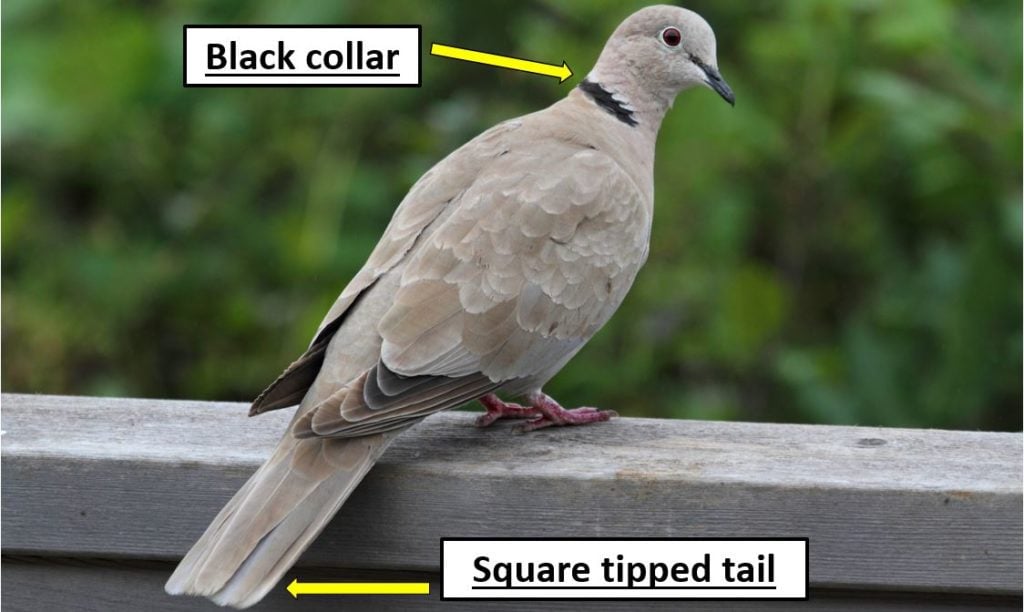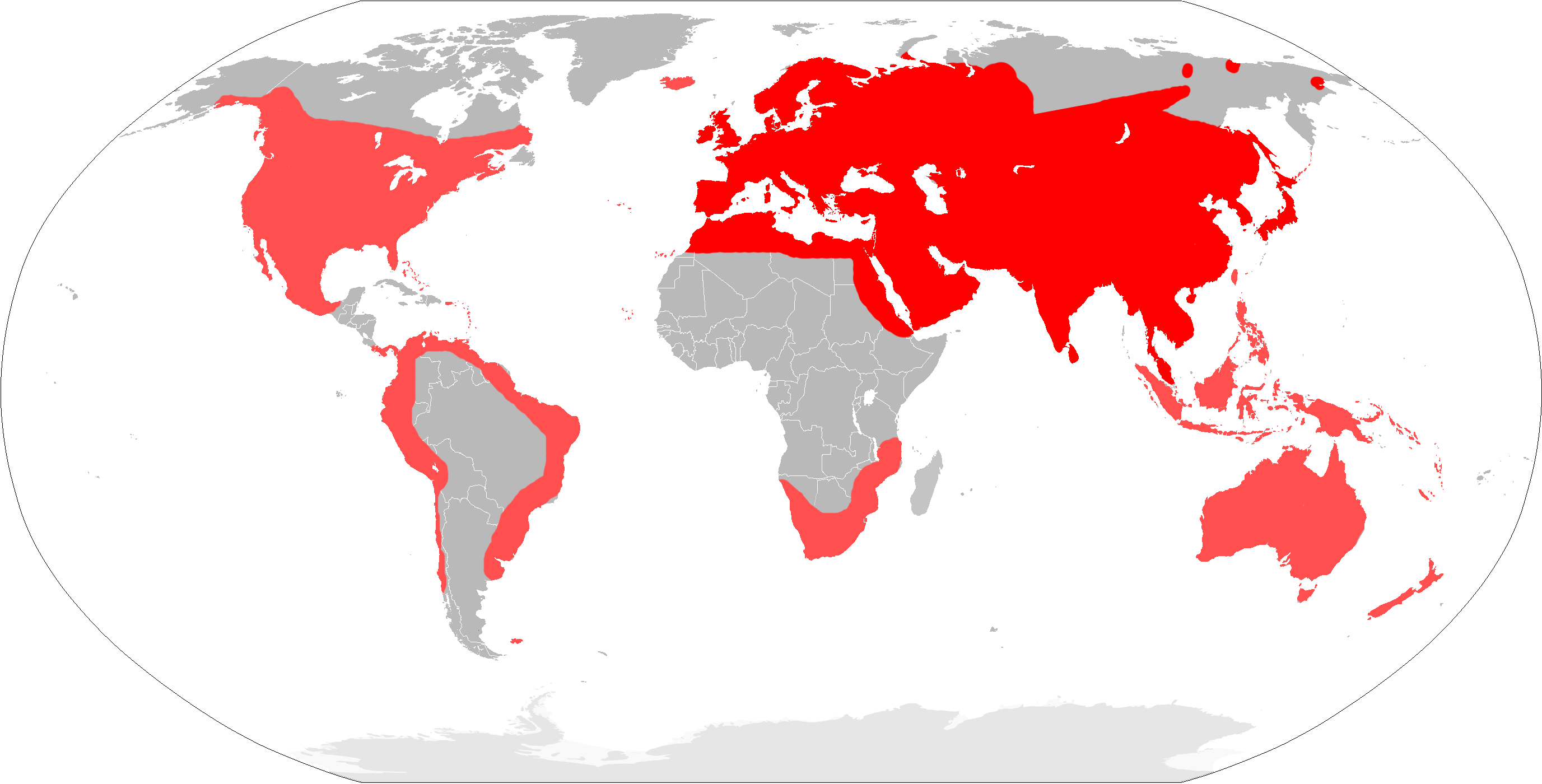8 INVASIVE Animals found in Missouri! (2025)
What kinds of invasive species can you find in Missouri?
Animals that are not native can cause many problems. They put a lot of pressure on native species as they compete for food, territories, and nesting areas.
Below, you will learn about an array of different invasive creatures, along with the myriad of problems they cause!
8 Invasive Animals Found in Missouri:
Just a quick note: you won’t find any insects or fish below. Those articles are coming soon! 🙂
#1. Rock Pigeon
- Columba livia

These invasive birds are common in Missouri but are almost exclusively found in urban areas. Rock Pigeons are what everyone refers to as “pigeons.” You have probably seen them gathering in huge flocks in city parks, hoping to get tossed some birdseed or leftover food.
The typical pigeon has a gray back, a blue-gray head, and two black wing bars. In addition, look for a green and purple iridescence around their necks!
Rock Pigeon Range Map
Love them or hate them, Rock Pigeons have been associated with humans for a long time! Some Egyptian hieroglyphics suggest that people started domesticating them over 5,000 years ago. But, interestingly, scientists aren’t even sure where their original range occurs!
#2. Domestic Cat
- Felis catus

- Can be a wide range of colors, sizes, shapes, and fur lengths.
- Selected mutations observed in many pet cats, such as folded ears, munchkin legs, or flattened faces, are not commonly seen among domestic cats successfully living feral.
Sadly, domestic cats are very damaging to the ecosystems in Missouri where they are introduced. It has only been in the last century or so that cats have become pets that stay indoors.
It is estimated that these invasive animals kill over 1 billion birds and 6 billion other small animals annually. Feral cats that live and breed away from the care of humans are the most prolific hunters.
As you can imagine, this issue is hotly debated due to the love people have for their pet cats. Some experts think that trap-neuter-return programs are key to curbing the problem of feral cats. At the same time, others are huge proponents of NEVER letting your cat outside.
#3. European Starling
- Sturnus vulgaris

- They are about the size of an American Robin. Their plumage is black and appears to be shiny.
- Breeding adults are darker black and have a green-purple tint.
- In winter, starlings lose their glossiness, their beaks become darker, and they develop white spots over their bodies.
Despite being common, European Starlings are an invasive species in Missouri.
Back in 1890, one hundred starlings were brought over from Europe and released in New York City’s Central Park. The man responsible (Eugene Schieffelin) had a mission to introduce all of the birds mentioned in Shakespeare’s plays to North America.
European Starling Range Map
The rest is history as starlings easily conquered the continent, along the way out-competing many of our beautiful native birds. Their ability to adapt to human development and eat almost anything is uncanny to virtually no other species.
Here’s something amazing about these non-native birds:
It’s the magical way they travel in flocks, called murmurations. Check out the video below because it’s mesmerizing. 🙂

#4. Wild Boar
- Sus scrofa

- Adults range from 5 to 8 feet in length and weigh between 145 and 600 pounds.
- Their thick, coarse hair ranges in color from black to reddish-brown.
- Males have large canines that protrude from the mouths of adult males.
Wild Boars are invasive mammals in Missouri, as they were introduced from overseas. Their population has exploded in the last 50-100 years, leading wildlife departments to implement population control programs.
Because of their aggressive nature and lack of fear, Wild Boars can be dangerous to livestock, humans, and pets. If you have a Wild Boar on your property or see one while you’re out and about, call your local animal control office for advice. Don’t try to approach this unpredictable animal!
They are omnivores, and what they eat varies with season and location. Wild Boars consume large amounts of plant matter, including fruits, nuts, roots, herbaceous plants, and crops. Their voracious appetite can be very detrimental to an ecosystem, causing a loss of plant diversity and extensive soil erosion.
#5. Eurasian Collared-Dove
- Streptopelia decaocto

- A mostly sandy gray bird with a long, square-tipped tail.
- As the name suggests, look for a black collar on the back of the neck.
Interestingly, these birds are invasive to Missouri.
Unfortunately, somebody introduced Eurasian Collared-Doves to the Bahamas in the 1970s, and since then, they have rapidly spread. In fact, their population is still spreading!
Eurasian Collared-Dove Range Map
One of the reasons these birds colonized here so quickly is due to their comfort level with humans. They have thrived being around bird feeders and in urban and suburban areas. It’s common to see them on the ground or platform feeders eating grains and seeds.
How do you tell them apart from Mourning Doves?
At first glance, Eurasian Collared-Doves look very similar to the native Mourning Dove. Here’s how to tell them apart:

- Mourning Doves are smaller and have black dots on their wings.
- Eurasian Collared-Doves are larger and have a black crescent around their neck.
#6. House Sparrow
- Passer domesticus

House Sparrows are an invasive species that originated from the Middle East. But now they are one of the most widespread birds in Missouri (and the world)!
House Sparrows owe their success to their ability to adapt and live near humans. Because of this, they are almost always found in urban and suburban areas.
Range Map – House Sparrow
House Sparrows can be heard across the entire planet. Pay attention the next time you’re watching the news in another country. Listen for a simple song that includes lots of “cheep” notes.

#7. House Mouse
- Mus musculus

- The tails are hairless and can be as long as their bodies.
- House Mice are smaller and lighter built than rats.
- They usually have light brown fur and large round ears compared to their heads, which give them a cute look.
These invasive rodents originated in Asia but can now be found in Missouri. House Mice arrived in North America on ships in the 1600s and quickly multiplied.
Mice have dispersed across the planet incredibly successfully, second perhaps only to humans. The biggest key to their success is their ability to adapt their behavior quickly and breed prolifically.
House Mouse Range Map

Salmonella and parasites are the most prevalent illnesses that mice transmit to humans by contaminating food. However, this risk has been greatly reduced through modern food management techniques in the USA.
House Mice also greatly impact the ecosystems that they invade. They are omnivorous and will devour plants and target animal species that have not adapted to fighting them off.
Fascinatingly, House Mice also cause the decline of native species by bolstering the health of predators through seasons when other prey would have been hard to find. By becoming prey themselves, the mice inflate the populations of predators year-round.
#8. Greylag Goose
- Anser anser

- Greylag Geese are a soft, warm gray-brown.
- Their feathers are rimmed with narrow white edges, which gives them a delicate barred pattern over their wings, chest, and sides.
- The legs are pink, while their bills are bright orange.
Greylag Geese are NOT native to Missouri!
These birds are found naturally across Europe and Asia, where they are very common and have a huge natural range.
Interestingly, Greylag Geese gave rise to almost all common domesticated goose breeds.
Domesticated Greylag Geese can commonly be seen on farms, estates, and in zoological collections. But, occasionally, escaped birds may flourish as feral populations.
Greylag Geese are very social animals. They will almost always be found in flocks, ranging from a few birds to thousands of animals. When flying, flocks adopt the classic V-shape flight formation. Play the video to see them in action!

Learn more about other animals in Missouri!
-
Most DANGEROUS Animals in Missouri!
-
MOST Common Birds in Missouri
-
Types of MAMMALS Found in Missouri!
Which of these invasive species have you seen in Missouri?
Leave a COMMENT below! 🙂






